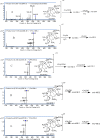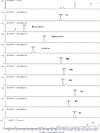Dynamic Variation Patterns of Aconitum Alkaloids in Daughter Root of Aconitum Carmichaelii (Fuzi) in the Decoction Process Based on the Content Changes of Nine Aconitum Alkaloids by HPLC- MS- MS
- PMID: 27610167
- PMCID: PMC4986097
Dynamic Variation Patterns of Aconitum Alkaloids in Daughter Root of Aconitum Carmichaelii (Fuzi) in the Decoction Process Based on the Content Changes of Nine Aconitum Alkaloids by HPLC- MS- MS
Abstract
The chemical components in the decoctions of Chinese herbal medicines are not always the same as those in the crude herbs because of the insolubility or instability of some compounds. In this work, a high-performance liquid chromatography (HPLC) coupled with electrospray ionization (ESI) tandem mass spectrometry method was developed to explore dynamic variation patterns of aconitum alkaloids in Fuzi during the process of decocting aconite root. The fragmentation patterns of aconitum alkaloids using ESI and collision-induced dissociation (CID) techniques were reported. This assay method was validated with respect to linearity (r(2) > 0.9950), precision, repeatability, and accuracy (recovery rate between 94.6 and 107.9%).The result showed that the amounts of aconitum alkaloids in the decoction at different boiling time varied significantly. In the decoction process,the diester- type alkaloids in crude aconite roots have transformed into Benzoylaconines or aconines.
Keywords: Fuzi; HPLC- MS- MS; aconite decoction; aconitum alkaloids; dynamic variation.
Figures




Similar articles
-
Exploring the ester-exchange reactions of diester-diterpenoid alkaloids in the aconite decoction process by electrospray ionization tandem mass spectrometry.Rapid Commun Mass Spectrom. 2003;17(4):279-84. doi: 10.1002/rcm.914. Rapid Commun Mass Spectrom. 2003. PMID: 12569436
-
[Study on Aconitum diterpenoid alkaloids from flowers of Aconitum kusnezoffi and its decoction by ESI-MS].Yao Xue Xue Bao. 2003 Apr;38(4):290-3. Yao Xue Xue Bao. 2003. PMID: 12889131 Chinese.
-
Discovery of effective combination from Renshen-Fuzi herbal pair against heart failure by spectrum-effect relationship analysis and zebrafish models.J Ethnopharmacol. 2023 Dec 5;317:116832. doi: 10.1016/j.jep.2023.116832. Epub 2023 Jun 21. J Ethnopharmacol. 2023. PMID: 37352946
-
Ethnopharmacological use, pharmacology, toxicology, phytochemistry, and progress in Chinese crude drug processing of the lateral root of Aconitum carmichaelii Debeaux. (Fuzi): A review.J Ethnopharmacol. 2023 Jan 30;301:115838. doi: 10.1016/j.jep.2022.115838. Epub 2022 Oct 17. J Ethnopharmacol. 2023. PMID: 36257343 Review.
-
A review on phytochemistry and pharmacological activities of the processed lateral root of Aconitum carmichaelii Debeaux.J Ethnopharmacol. 2015 Feb 3;160:173-93. doi: 10.1016/j.jep.2014.11.043. Epub 2014 Dec 3. J Ethnopharmacol. 2015. PMID: 25479152 Review.
Cited by
-
De Novo RNA Sequencing and Expression Analysis of Aconitum carmichaelii to Analyze Key Genes Involved in the Biosynthesis of Diterpene Alkaloids.Molecules. 2017 Dec 5;22(12):2155. doi: 10.3390/molecules22122155. Molecules. 2017. PMID: 29206203 Free PMC article.
-
Therapeutic effects of Qian-Yu decoction and its three extracts on carrageenan-induced chronic prostatitis/chronic pelvic pain syndrome in rats.BMC Complement Altern Med. 2017 Jan 25;17(1):75. doi: 10.1186/s12906-016-1553-7. BMC Complement Altern Med. 2017. PMID: 28122556 Free PMC article.
-
Quantitative Analysis of Eight Triterpenoids and Two Sesquiterpenoids in Rhizoma Alismatis by Using UPLC-ESI/APCI-MS/MS and Its Application to Optimisation of Best Harvest Time and Crude Processing Temperature.J Anal Methods Chem. 2019 Aug 14;2019:8320171. doi: 10.1155/2019/8320171. eCollection 2019. J Anal Methods Chem. 2019. PMID: 31485369 Free PMC article.
-
Qualitative Profiling and Quantitative Analysis of Major Constituents in Jinmu-tang by UHPLC-Q-Orbitrap-MS and UPLC-TQ-MS/MS.Molecules. 2022 Nov 15;27(22):7887. doi: 10.3390/molecules27227887. Molecules. 2022. PMID: 36432001 Free PMC article.
-
Unveiling Dynamic Changes of Chemical Constituents in Raw and Processed Fuzi With Different Steaming Time Points Using Desorption Electrospray Ionization Mass Spectrometry Imaging Combined With Metabolomics.Front Pharmacol. 2022 Mar 10;13:842890. doi: 10.3389/fphar.2022.842890. eCollection 2022. Front Pharmacol. 2022. PMID: 35359875 Free PMC article.
References
-
- Ministry of Public Health of the People’s Republic of China. Pharmacopoeia of the People’s Republic of China. Vol 1, the Ministry, China. 2010:177–178.
-
- Tai YT, But PP, Young K, Lau CR. Cardiotoxicity after accidental herb induced aconite poisoning. Lancet. 1992;340:1254–1256. - PubMed
-
- Konno C, Shirasaka M, Hikino H. Cardioactive principle of aconitum carmichaeli roots. Planta Med. 1979;35:150–155. - PubMed
-
- Lin CC, Chan TYK, Deng JF. Clinical features and management of herb induced aconitine poisoning. Ann Emerg Med. 2004;43:574–579. - PubMed
-
- Chan TYK. Aconite poisoning presenting as hypotension and bradycardia. Hum Exp Toxicol. 2009;28:759–797. - PubMed
LinkOut - more resources
Full Text Sources
